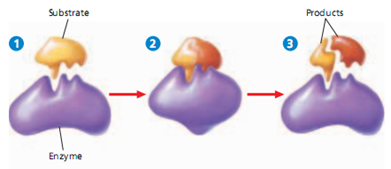Enzyme is a protein molecule that act as biological catalysts, and essential for the functioning of any cell. Many enzymes are proteins. Figure below shows an induced fit model of enzyme action.
Enzyme reactions depend on a physical fit between the enzyme molecule and its specific substrate, the reactant being catalyzed.
Notice that the enzyme has folds, or an active site, with a shape that allows the substrate to fit into the active site. An enzyme acts only on a specific substrate because only that substrate fits into its active site. The linkage of the enzyme and substrate causes a slight change in the enzyme’s shape. The change in the enzyme’s shape weakens some chemical bonds in the substrate, which is one way that enzymes reduce activation energy, the energy needed to start the reaction. After the reaction, the enzyme releases the products. Like any catalyst, the enzyme itself is unchanged, so it can be used many times. An enzyme may not work if its environment is changed. For example, change in temperature or pH can cause a change in the shape of the enzyme or the substrate. If such a change happens, the reaction that the enzyme would have catalyzed cannot occur.







0 comments :
Post a Comment